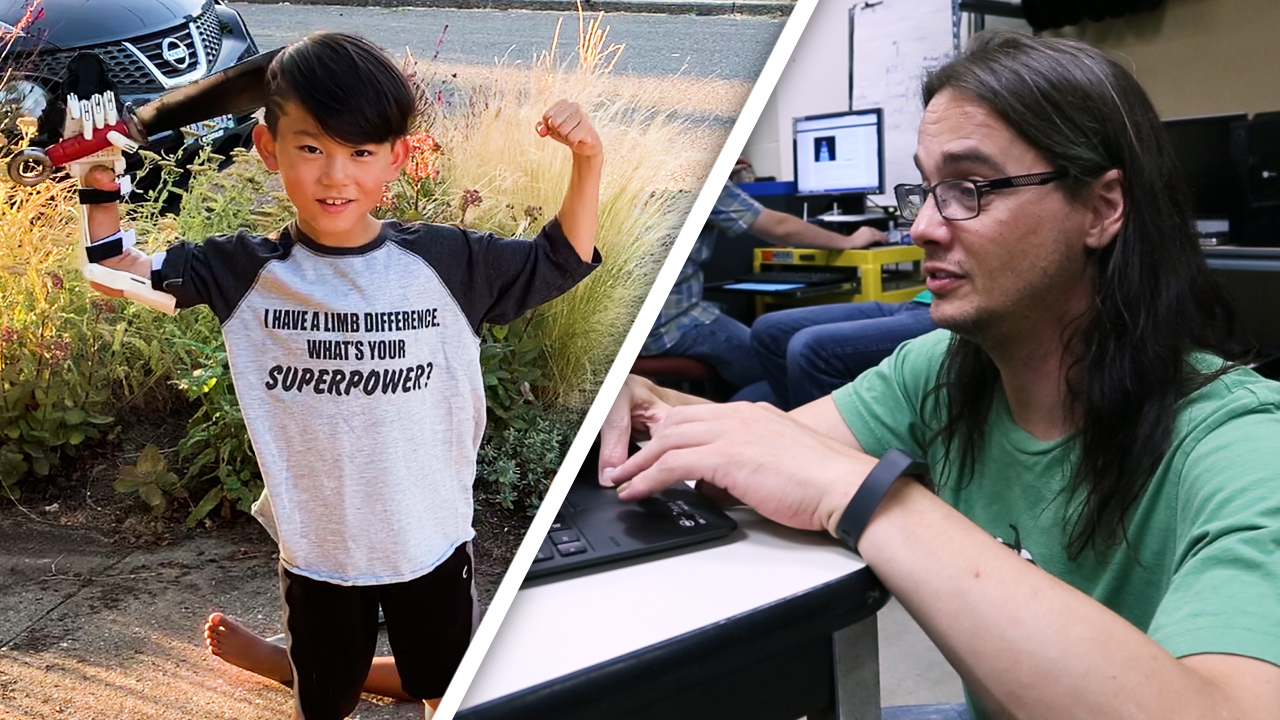Oregon Intel employee helps boy with 3D-printed prosthetic

Henry Hunker was born eight years ago with an underdeveloped hand. Modern limb prosthetics can cost upwards of $100,000, but thanks to 3-D Samaritans, Henry now has a hand that costs less than $10 — and other kids think it looks pretty cool, too.
E-Nable, a volunteer group of over 1,500 members working on mechanical hand assistive devices with 3-D printers, helped give Henry his new plastic hand in 2014. Henry’s parents, Philip and Laura Hunker, sought the help of E-Nable and were connected with a local volunteer in the Portland, Oregon, area. That person was Wayne Waterman, who by day was working as a network engineer at Intel.
“I coined a phrase – I think I coined it – ‘3-D Samaritanism’,” Waterman said. “I have a 3-D printer. It costs me less than $10 to give somebody a prosthetic hand. And if you can do that sort of thing, you really should.”
Henry’s will be the fifth hand that Waterman has printed for someone in need, but the design still has room for improvements.
“Henry’s going to be a really interesting case because the technology is moving so fast… He’s only 2 years old now and the amount that he is going to grow is going to be kind of analogue with how fast the technology is going to grow,” Waterman said in 2014. “And as he grows, because they live in Portland, I’m going to be able to make the next iterations, as he gets bigger.”
And that’s exactly what has happened over the years. Henry is now 8 years old. He’s bigger — and he’s now in school where bullies have sometimes teased Henry about his missing limb. But things changed in third grade. Henry came up with a design to resemble a dragon, and Waterman turned it into reality.
“When I made Henry his first hand, it was because he was missing a hand,” said Waterman, now a webcast infrastructure architect in Intel’s Information Technology Group in Hillsboro. “When I made him the second hand, it was because it gave him some street cred at school.”
-This story was first published in ESOL News Oregon January 18, 2021.
Check
Discuss
- Look up the word “prosthetic” in an online English-English dictionary like Longman. How many syllables does it have? Which syllable has the stress?
- “Prosthetic” can be used as a noun or an adjective. What does it mean? Take another look in an online English-English dictionary like Longman. It’s used both ways in the article. Can you find examples of each part of speech in the article? Compare with your group members. Do you agree?
- “Limb” is a one syllable word. The final “b” is silent. Do you know other words with silent “b” in the middle of the word or at the end? “Limb” can refer to a part of the human body or a part of a tree. How are the two meanings related? Check the pronunciation and meaning in an online English-English dictionary like Longman.
- The article says that Henry’s new dragon hand gives him “street cred” at school. Do a little research on this phrase. Once you understand it, talk with your group about other ways students establish “street cred.” Did you need to establish street cred when you were a student in your country or as a student now in the U.S.?
Write
- The group that creates prosthetics gets its name from the expression “Good Samaritan,” which originates in the Bible, but is used more generally to mean a person who does a good deed. Think of other examples of Good Samaritans, whether they are people you know personally or people you have read about in other texts (fiction or non-fiction) or seen in films. What did they do? Who did they help?
- Brainstorm other ways 3-D printing can help people for very little money. After you have thought of some ideas, check online to see if any of your ideas have actually been tried.
- Waterman said 3-D printing technology changes very quickly. What do you think 3-D printing will be able to do in the future, good and bad? For example, can weapons or other ways of hurting people be created with 3-D printing?
- Sometimes the work people do as volunteers can be more meaningful than the paid work they do for their job. Do you agree? Why or why not? Use the story of Henry and the volunteer Waterman from the article to explain your ideas. Add more examples from your own work and/or job experience.
Sources
“3-D Samaritans Print New Mechanical Hand for Toddler.” Intel Newsroom, 19 Nov. 2014, newsroom.intel.com/editorials/3d-printing-hand-prosthetic/#gs.qaoefm. Accessed 16 Jan. 2021.
“Prosthetic Hand Builds Street Cred and a Lasting Friendship.” Intel Newsroom, 27 Sept. 2020, newsroom.intel.com/news/prosthetic-hand-builds-street-cred-lasting-friendship/#gs.qaq7bf. Accessed 16 Jan. 2021.

